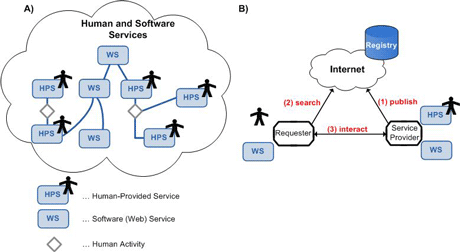by Daniel Schall and Schahram Dustdar
In most cases, service-oriented architecture is realized using Web services technology. At the Vienna University of Technology, we have implemented a platform enabling humans to provide services. We foresee important applications that will be based on Human-Provided Services and software services.
Service-oriented Architectures (SOA) are typically comprised of software services. Many collaboration and composition scenarios involve interaction between human actors as well as software services. Current tools and platforms offer limited support for human interactions in SOA: we therefore present Human-Provided Services (HPS) and the HPS framework. In particular, the aim of the HPS framework is to:
- offer a service registry maintaining information related to human and software services
- enhance service-related information by describing human characteristics and capabilities
- define interaction patterns using Web services technology so that human actors can efficiently deal with interactions.
HPSs are offered by human actors. Web services technology is used to describe HPSs and to enable interaction with real people. The advantage of HPS is that these services can be used in different compositions and Web-based collaborations.
A possible scenario of human and software services is shown in Figure 1a. A human can define an activity, eg 'review document activity', which is transformed into a Web service interface. Such interfaces are typically described using the Web Services Description Language (WSDL). The same standards can be used to describe HPSs and software (Web) services.

Via a graphical user interface - a Web 2.0 portal hosted by the HPS framework - the end user can create HPSs without having to understand XML or Web services technology.
The role of humans in the future Internet and SOA is thus not limited to consuming services (Figure 1b); services can also be provided by human actors. HPS unifies humans and services, because a service can be provided by a human actor or implemented as a software service. Three steps are performed when using HPS:
1) Publish: the user can create an HPS and publish the service on the Web using a registry. Publishing a service is as simple as posting a blog entry on the Web. It is the association of the users profile with an activity depicted as a service.
2) Search: the requester can perform a keyword-based search to find HPSs. Ranking is performed to find the most relevant HPS based on, for example, the expertise of the user providing the service.
3) Interact: the framework supports automatic user interface generation. HPS can be used in interactions between humans and in interactions between software services and HPSs.
The HPS framework is comprised of three layers (Figure 2). The first layer contains data collections to maintain user profile information, service descriptions (WSDL and related information) and interaction rules. These rules can be created by the user to define event-condition-action patterns such as pre-filtering of interactions, messages etc.

The second layer contains user tools including a graphical user interface for designing services (a simple tool to create HPSs without programming code), the activity management to organize and structure activities, interactions and related messages. The service management allows the user to modify his/her HPSs.
The third layer enables interaction between requesters and HPSs. The lookup is used to find suitable services, with matching HPSs being ranked and returned (comparable to using search engines on the Web). The access layer is a proxy service dispatching messages that are exchanged in HPS-based interactions.
The middleware services are implemented in Java/J2EE and data collections are managed with XML databases (to manage WSDL- and XML-type definitions) and MySQL to manage interactions and related messages.
The user tools are mainly implemented in C# and ASP.NET with the support of automatic user interface generation using XForm (XML forms) technology. These forms are generated based on XML descriptions (eg WSDL).
The framework offers APIs (lookup, registry), enabling integration with other platforms.
Link:
http://hydra.infosys.tuwien.ac.at/prototyp/HPS/HPS_index.html
Please contact:
Daniel Schall
Vienna University of Technology / AARIT, Austria
Tel: +43 1 58801 18453
E-mail: schall![]() infosys.tuwien.ac.at
infosys.tuwien.ac.at
Schahram Dustdar
Vienna University of Technology / AARIT, Austria
Tel: +43 1 58801 18414
E-mail: dustdar![]() infosys.tuwien.ac.at
infosys.tuwien.ac.at










